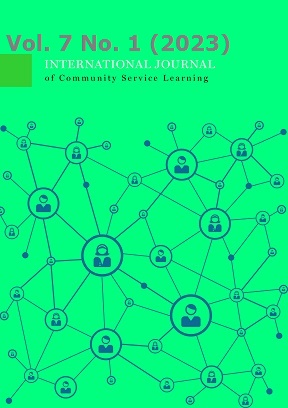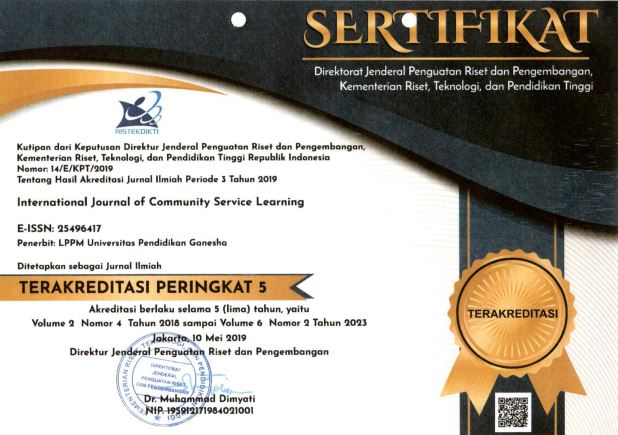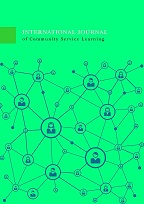Education on Electromagnetic Waves Exposure from Smart Devices in Elementary School
DOI:
https://doi.org/10.23887/ijcsl.v7i1.55713Kata Kunci:
Electromagnetic Wave Radiation, Smart Device, SmartphoneAbstrak
Advances in science and technology are increasingly sophisticated and complex. Smart devices, smartphones, tablets, and other complicated media mark the rapid development of communication technology. Smart devices are electronic devices, generally connected to other devices or networks via different wireless protocols. One example of a smart device that is widely used is a smartphone. People frequently use smartphones as a communication tool in the current global era. As a result, most people are dependent on these devices, which can expose them to harmful electromagnetic waves. Given the dangers smartphones can cause to people, it is recommended to limit the use of smartphones. Therefore, the purpose of implementing this community service is to educate the public, especially students and teachers at SDN 16 Bekut, on the dangers of smartphone radiation. This is done by educating people about the need to use smartphones responsibly and not excessively. Based on the questionnaire results and recapitulation of the results of this activity, it was found that the level of understanding and satisfaction index of the actifvity participants reached 86.45%.
Referensi
Akhtar, F., Patel, P. K., Heyat, M. B. bin, Yousaf, S., Baig, A. A., Mohona, R. A., Mutoffar, M. M., Bhattacharya, T., Teelhawod, B. N., Li, J., Kamal, M. A., & Wu, K. (2022). Smartphone Addiction among Students and Its Harmful Effects on Mental Health, Oxidative Stress, and Neurodegeneration towards Future Modulation of Anti-Addiction Therapies: A Comprehensive Survey Based on SLR, Research Questions, and Network Visualization. CNS & Neurological Disorders - Drug Targets, 12. https://doi.org/10.2174/1871527321666220614121439. DOI: https://doi.org/10.2174/1871527321666220614121439
Aravinda, V. S. S., Kandregula, C. R., Muppa, R., Krishna, M. M., Nikitha, B. S., & Yenni, M. (2022). A cross-sectional and histological analysis to understand the cytological effects of cell phone radiation on buccal mucosa of children. Journal of Indian Society of Pedodontics and Preventive Dentistry, 40(1), 74.
Atya, A. K., & Murad, F. A. (2022). Calculation of the Energy Density Levels of the Rays Emitted from Mobile Phone Towers in Jableh District Center. Journal of Pharmaceutical Negative Results, 13(7), 156–162.
Bhargava, D., Leeprechanon, N., Rattanadecho, P., & Wessapan, T. (2019). Specific absorption rate and temperature elevation in the human head due to overexposure to mobile phone radiation with different usage patterns. International Journal of Heat and Mass Transfer, 130, 1178–1188. https://doi.org/10.1016/j.ijheatmasstransfer.2018.11.031. DOI: https://doi.org/10.1016/j.ijheatmasstransfer.2018.11.031
Choi, Y.-J., & Choi, Y.-S. (2016). Effects of Electromagnetic Radiation from Smartphones on Learning Ability and Hippocampal Progenitor Cell Proliferation in Mice. Osong Public Health and Research Perspectives, 7(1), 12–17. https://doi.org/10.1016/j.phrp.2015.12.009. DOI: https://doi.org/10.1016/j.phrp.2015.12.009
Csibi, S., Griffiths, M. D., Demetrovics, Z., & Szabo, A. (2021). Analysis of problematic smartphone use across different age groups within the ‘components model of addiction. International Journal of Mental Health and Addiction, 19, 616–631. DOI: https://doi.org/10.1007/s11469-019-00095-0
Deruelle, F. (2020). The different sources of electromagnetic fields: Dangers are not limited to physical health. Electromagnetic Biology and Medicine, 39(2), 166–175. https://doi.org/10.1080/15368378.2020.1737811. DOI: https://doi.org/10.1080/15368378.2020.1737811
Dong, C., Cao, S., & Li, H. (2020). Young children’s online learning during COVID-19 pandemic: Chinese parents’ beliefs and attitudes. Children and Youth Services Review, 118, 105440. https://doi.org/10.1016/j.childyouth.2020.105440. DOI: https://doi.org/10.1016/j.childyouth.2020.105440
Han, Q., & Cho, D. (2016). Characterizing the technological evolution of smartphones. Proceedings of the 18th Annual International Conference on Electronic Commerce E-Commerce in Smart Connected World - ICEC ’16, 1–8. https://doi.org/10.1145/2971603.2971635. DOI: https://doi.org/10.1145/2971603.2971635
Hardell, L. (2017). World Health Organization, radiofrequency radiation and health-a hard nut to crack. International Journal of Oncology, 51(2), 405–413. https://doi.org/10.3892/ijo.2017.4046. DOI: https://doi.org/10.3892/ijo.2017.4046
Howell, R. G., Petersen, S. L., Balzotti, C. S., Rogers, P. C., Jackson, M. W., & Hedrich, A. E. (2019). Using WebGIS to Develop a Spatial Bibliography for Organizing, Mapping, and Disseminating Research Information: A Case Study of Quaking Aspen. Rangelands, 41(6), 244–247. https://doi.org/10.1016/j.rala.2019.10.001 DOI: https://doi.org/10.1016/j.rala.2019.10.001
Imansyah, F., Putra, L. S. A., & Kusumawardhani, E. (2021). Measurement and Analysis of Radiation Levels from Base Transceiver Station in Sambas. Journal of Information Systems and Telecommunication (JIST), 9(36), 1–9. https://doi.org/10.52547/jist.9.36.1. DOI: https://doi.org/10.52547/jist.9.36.1
Kesari, K. K., Agarwal, A., & Henkel, R. (2018). Radiations and male fertility. Reproductive Biology and Endocrinology, 16(1), 118. https://doi.org/10.1186/s12958-018-0431-1. DOI: https://doi.org/10.1186/s12958-018-0431-1
Khan, M. A., Vivek, Nabi, M. K., Khojah, M., & Tahir, M. (2021). Students’ Perception towards E-Learning During Covid-19 Pandemic In India: An Empirical Study. Sustainability, 13(1). https://doi.org/10.3390/su13010057. DOI: https://doi.org/10.3390/su13010057
Kim, J. H., Lee, J.-K., Kim, H.-G., Kim, K.-B., & Kim, H. R. (2019). Possible Effects of Radiofrequency Electromagnetic Field Exposure on Central Nerve System. Biomolecules & Therapeutics, 27(3), 265–27. https://doi.org/10.4062/biomolther.2018.152. DOI: https://doi.org/10.4062/biomolther.2018.152
Kim, K.-H., Kabir, E., & Jahan, S. A. (2016). The use of cell phone and insight into its potential human health impacts. Environmental Monitoring and Assessment, 188(4), 221. https://doi.org/10.1007/s10661-016-5227-1. DOI: https://doi.org/10.1007/s10661-016-5227-1
Kohdrata, N., Suartika, G. A. M., Krisnandika, A. A. K., Yusiana, L. S., & Dharmadiatmika, I. M. A. (2019). The spectrum of city park service scope: case study of Lapangan Puputan Badung and Lapangan Puputan Margarana Denpasar-Bali. In IOP Conference Series: Earth and Environmental Science, 396(1), 012042. https://doi.org/10.1088/1755-1315/396/1/012042. DOI: https://doi.org/10.1088/1755-1315/396/1/012042
Materia, F. T., Faasse, K., & Smyth, J. M. (2020). Understanding and Preventing Health Concerns About Emerging Mobile Health Technologies. JMIR MHealth and UHealth, 8(5), e14375. https://doi.org/10.2196/14375. DOI: https://doi.org/10.2196/14375
Meena, J., Verma, A., Kohli, C., & Ingle, G. (2016). Mobile phone use and possible cancer risk: Current perspectives in India. Indian Journal of Occupational and Environmental Medicine, 20(1), 5. https://doi.org/10.4103/0019-5278.183827. DOI: https://doi.org/10.4103/0019-5278.183827
Mertz, L. (2016). Are Wearables Safe?: We Carry Our Smart Devices with Us Everywhere - Even to Bed - But Have We Been Sleeping with the Enemy, or are Cautionary Tales Overinflated? IEEE Pulse, 7(1), 39–43. https://doi.org/10.1109/MPUL.2015.2498477. DOI: https://doi.org/10.1109/MPUL.2015.2498477
Miller, A. B., Sears, M. E., Morgan, L. L., Davis, D. L., Hardell, L., Oremus, M., & Soskolne, C. L. (2019). Risks to Health and Well-Being From Radio-Frequency Radiation Emitted by Cell Phones and Other Wireless Devices. Frontiers in Public Health, 7. https://doi.org/10.3389/fpubh.2019.00223. DOI: https://doi.org/10.3389/fpubh.2019.00223
Moradi, M., Naghdi, N., Hemmati, H., Asadi-Samani, M., & Bahmani, M. (2016). Effects of the Effect of Ultra High Frequency Mobile Phone Radiation on Human Health. Electronic Physician, 8(5), 2452–2457. https://doi.org/10.19082/2542. DOI: https://doi.org/10.19082/2542
Negi, P., & Singh, R. (2021). Association between reproductive health and nonionizing radiation exposure. Electromagnetic Biology and Medicine, 40(1), 92–102. https://doi.org/10.1080/15368378.2021.1874973. DOI: https://doi.org/10.1080/15368378.2021.1874973
Park, C. S. (2019). Examination of smartphone dependence: Functionally and existentially dependent behavior on the smartphone. Computers in Human Behavior, 93, 123–128. https://doi.org/10.1016/j.chb.2018.12.022. DOI: https://doi.org/10.1016/j.chb.2018.12.022
Rahaman, M. N. (2017). Ceramic processing and sintering, second edition. Ceramic Processing and Sintering, Second Edition, 1–875. https://doi.org/10.1201/9781315274126. DOI: https://doi.org/10.1201/9781315274126-1
Sari, N., Saputra, M., & Husein, J. (2017). Pengaruh Electronic Word of Mouth Terhadap Keputusan Pembelian Pada Toko Online Bukalapak.Com. Jurnal Manajemen Magister, 03(01), 96–106. https://jurnal.darmajaya.ac.id/index.php/jmmd/article/view/968/615.
Serrano-Estrada, L., Martin, T. J., & Marti, P. (2021). Understanding city dynamics: using geolocated social media in a problem-based activity as an investigative tool to enhance student learning. Journal of Geography in Higher Education. https://doi.org/10.1080/03098265.2021.2004390. DOI: https://doi.org/10.1080/03098265.2021.2004390
Sleptcova, M., & Falkenbach, H. (2020). Managerial Skill and European PERE Fund Performance. Journal of Real Estate Finance and Economics. https://doi.org/10.1007/s11146-020-09779-0. DOI: https://doi.org/10.1007/s11146-020-09779-0
Suminar, S. O., & Meilani, R. I. (2016). Pengaruh Model Pembelajaran Discovery Learning Dan Problem Based Learning Terhadap Prestasi Belajar Peserta Didik. Jurnal Pendidikan Manajemen Perkantoran, 1(1), 80–89. https://doi.org/10.17509/jpm.v1i1.3339. DOI: https://doi.org/10.17509/jpm.v1i1.3339
Susilawati, S., & Supriyatno, T. (2020). Online Learning Through WhatsApp Group in Improving Learning Motivation in the Era and Post Pandemic COVID -19. Jurnal Pendidikan: Teori, Penelitian, Dan Pengembangan, 5(6), 852–859. http://journal.um.ac.id/index.php/jptpp/article/vi. DOI: https://doi.org/10.17977/jptpp.v5i6.13670
Thakur, H., Master, M., & Bharti, S. (2020). Smart Wall Clock with an Electric Eye. Procedia Computer Science, 170, 1071–1076. https://doi.org/10.1016/j.procs.2020.03.071. DOI: https://doi.org/10.1016/j.procs.2020.03.071
Vargo, D., Zhu, L., Benwell, B., & Yan, Z. (2021). Digital technology use during COVID‐19 pandemic: A rapid review. Human Behavior and Emerging Technologies, 3(1), 13–24. DOI: https://doi.org/10.1002/hbe2.242
Wilmer, H. H., Sherman, L. E., & Chein, J. M. (2017). Smartphones and Cognition: A Review of Research Exploring the Links between Mobile Technology Habits and Cognitive Functioning. Frontiers in Psychology, 8. https://doi.org/10.3389/fpsyg.2017.00605. DOI: https://doi.org/10.3389/fpsyg.2017.00605
Yan, Z. (2018). Child and Adolescent Use of Mobile Phones: An Unparalleled Complex Developmental Phenomenon. Child Development, 89(1), 5–16. https://doi.org/10.1111/cdev.12821. DOI: https://doi.org/10.1111/cdev.12821
Unduhan
Diterbitkan
Cara Mengutip
Terbitan
Bagian
Lisensi
Hak Cipta (c) 2023 Eka Kusumawardhani, Leonardus Sandy Ade Putra, Putranty Widha Nugraheni, Lalak Tarbiyatun Nasyin Maleiva, Romario Aldrian Wicaksono

Artikel ini berlisensiCreative Commons Attribution-ShareAlike 4.0 International License.

International Journal of Comunnity Service Learning is licensed under a Creative Commons Attribution-ShareAlike 4.0 International License.













